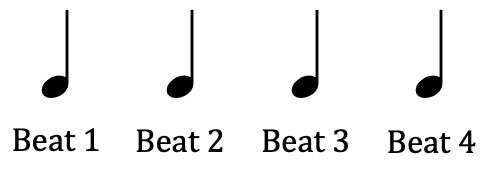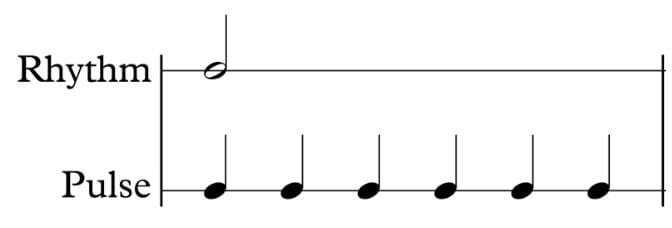So far, we’ve seen the relative durations of the note values
. We know, for example, that a half note is half the whole note and also double the quarter note. We know also that the quarter note is half the half note as well as double the eighth note and so on.
But how do we know the duration of these notes in real time? How do we decide how short or long a note should actually be played for?
For this we need a more complete picture of rhythm, and an important part of it is the musical pulse
. This is one aspect of how we measure musical time. The pulse is that constant, underlying throb that is felt in music as it plays along. It’s often referred to simply as the beat
. It’s what people tap their feet to when listening to a song.
Here’s a basic visual representation of a pulse. It’s just a simple row of squares, but observe that they’re equal in size and they’re always the same distance apart. This is because the pulse is steady, consistent, and all the beats are the same duration:
Now to measure musical time accurately, we have to decide what these beats are worth
. And to do this we must assign a note value to the pulse. So instead of squares, we’ll put a note value, let’s say for example, quarter notes. Here we have a quarter note pulse
where every beat is a quarter note.
4 quarter note beats in a row
This is useful because now that we know that 1 beat is 1 quarter note, we can measure how many beats every other note value is worth. (We can do this because we already know the relative durations of our note values from day 1.) If the quarter note is one beat
, then the whole note is 4 beats, the half note is 2 beats, the eighth note is one-half of a beat, and the sixteenth note is one-fourth of a beat.
If one beat = one quarter note, then:
A sixteenth note = one fourth of a beat
An eighth note = one half of a beat
A quarter note = one beat
A half note = two beats
A whole note= four beats
Later in the course, we’ll see how rhythms are built on top of the pulse, but here’s a simple demonstration. This is a short quarter note pulse:
A short quarter note pulse
What can we do with it?
We can build rhythms above it using note values! For example, on top of the first two quarter notes we can put one half note.
On the next four quarter notes, we can put one whole note:
Or another half note and two quarter notes:
As we explore rhythm throughout this book, you’ll see that the variety is endless! When we add pitches to rhythms, we get melodies, bass lines, accompaniments and other musical features. Underneath it all, there is always this constant musical pulse.






